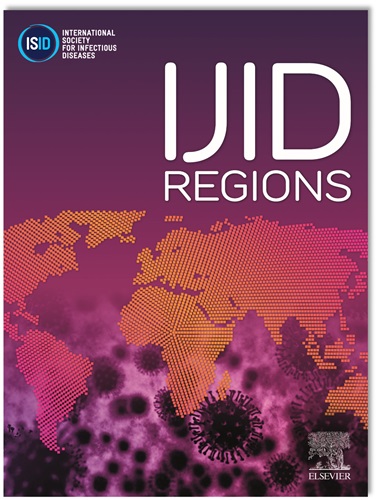Surveillance of H. pylori prevalence and antibiotic resistance in the urban Chinese population: a nationwide multi-center study
IF 4.8
2区 医学
Q1 INFECTIOUS DISEASES
引用次数: 0
Abstract
Introduction
China has a high antibiotic-resistant H. pylori infection burden. The current knowledge of H. pylori prevalence and antibiotic resistance in China is mainly based on meta-analysis and systematic review. In addition, since H. pylori prevalence is tightly associated with economic development, the H. pylori infection and antibiotic resistance rates in the urban Chinese population may be significantly changed due to the rapid socioeconomic development over the past twenty-year urbanization. However, the actual situation is unknown. Therefore, this study conducted a nationwide, multi-center, cross-sectional surveillance using the string test coupled with qPCR to provide an accurate overview of H. pylori prevalence and antibiotic resistance to clarithromycin and levofloxacin in urban China.
Methods
From March to November 2023, 12,902 individuals aged from 18 to 60 years old were recruited from 52 cities belonging to 26 out of 31 provinces in mainland China. All the individuals were examined for H. pylori infection and antibiotic resistance to clarithromycin and levofloxacin via quantitative PCR of gastric fluid samples collected through string test. All results were statistically analyzed via univariate analysis.
Results
Among all participants, the average individual-based H. pylori infection rate in urban China was 27.08%. Among 26 out of 31 provinces, the infection rates of H. pylori ranged from 15.25% in Hunan to 41.47% in Fujian. According to the division of seven geographic regions, Eastern China has the highest H. pylori infection rate of 32.45%. As for antibiotic resistance of H. pylori, the average clarithromycin resistance rate is 50.82%, while the average levofloxacin resistance rate is 47.17%.
Discussion
The investigation discloses that the prevalence of H. pylori among urban Chinese is notably lower than previous reports. This variance, indicative of improvement, can be attributed to the progressive enhancement of sanitary conditions and advancements in medical care within urban regions of mainland China over the preceding two decades. In addition, it was found that the resistance rates to clarithromycin and levofloxacin are unexpectedly high in the urban Chinese population. This may be related to the increased use of antibiotics to treat gram-negative bacterial infections. It is imperative to highlight the strengths of this investigation, which encompass the application of a singular methodology for precise evaluation of the present prevalence of H. pylori and antibiotic resistance within the urban Chinese population. Meanwhile, notable limitations of this study involve discrepancies in sample sizes and the absence of data from five provinces.
Conclusion
This study updates our understanding of the current prevalence and antibiotic resistance to clarithromycin and levofloxacin of H. pylori in urban China. This suggests that future public health strategies should focus on managing antibiotic use, and susceptibility-guided therapy should be adopted for clinical practice to help improve the successful eradication of H. pylori infection.
中国城市人群幽门螺杆菌患病率和抗生素耐药性监测:一项全国性多中心研究
中国的幽门螺杆菌耐药感染负担较高。目前对中国幽门螺杆菌患病率和抗生素耐药性的了解主要基于meta分析和系统综述。此外,由于幽门螺杆菌患病率与经济发展密切相关,中国城市人口幽门螺杆菌感染率和抗生素耐药率可能由于过去20年城市化中社会经济的快速发展而发生显著变化。然而,实际情况尚不清楚。因此,本研究在全国范围内开展了多中心的横断面监测,采用串试验与qPCR相结合的方法,以准确概述中国城市幽门螺杆菌的流行情况以及对克拉霉素和左氧氟沙星的耐药性。方法于2023年3月至11月,从中国大陆31个省中的26个省的52个城市招募年龄在18岁至60岁之间的12902人。采用串法采集胃液标本进行定量PCR检测幽门螺杆菌感染情况及对克拉霉素和左氧氟沙星的耐药性。所有结果通过单变量分析进行统计分析。结果在所有参与者中,中国城市平均幽门螺杆菌感染率为27.08%。31个省份中26个省份幽门螺杆菌感染率从湖南的15.25%到福建的41.47%不等。按7个地理区域划分,华东地区幽门螺杆菌感染率最高,为32.45%。在抗生素耐药性方面,幽门螺杆菌克拉霉素平均耐药率为50.82%,左氧氟沙星平均耐药率为47.17%。调查显示,中国城市幽门螺杆菌患病率明显低于以往报道。这种差异表明情况有所改善,这可以归因于过去二十年来中国大陆城市地区卫生条件的逐步改善和医疗保健的进步。此外,我们还发现中国城市人群对克拉霉素和左氧氟沙星的耐药率出乎意料地高。这可能与增加使用抗生素治疗革兰氏阴性细菌感染有关。当务之急是要强调这项调查的优势,其中包括应用一种独特的方法来精确评估目前中国城市人口中幽门螺杆菌的患病率和抗生素耐药性。同时,本研究的显著局限性包括样本量的差异和缺乏来自五个省份的数据。结论本研究更新了中国城市幽门螺旋杆菌的流行现状及对克拉霉素和左氧氟沙星的耐药性。这表明,未来的公共卫生策略应侧重于管理抗生素的使用,并应在临床实践中采用敏感性指导治疗,以帮助成功根除幽门螺杆菌感染。
本文章由计算机程序翻译,如有差异,请以英文原文为准。
求助全文
约1分钟内获得全文
求助全文
来源期刊
CiteScore
18.90
自引率
2.40%
发文量
1020
审稿时长
30 days
期刊介绍:
International Journal of Infectious Diseases (IJID)
Publisher: International Society for Infectious Diseases
Publication Frequency: Monthly
Type: Peer-reviewed, Open Access
Scope:
Publishes original clinical and laboratory-based research.
Reports clinical trials, reviews, and some case reports.
Focuses on epidemiology, clinical diagnosis, treatment, and control of infectious diseases.
Emphasizes diseases common in under-resourced countries.

 求助内容:
求助内容: 应助结果提醒方式:
应助结果提醒方式:


